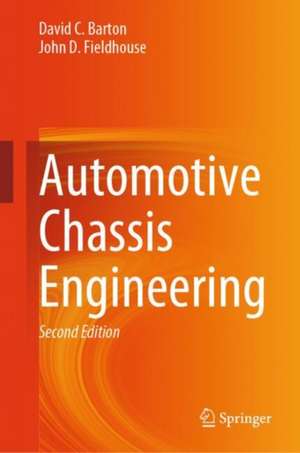Automotive Chassis Engineering
Autor David C. Barton, John D. Fieldhouseen Limba Engleză Hardback – 6 iun 2024
Written for students and practising engineers working in automotive engineering, this book provides a fundamental yet comprehensive understanding of chassis systems and requires little prior knowledge on the part of the reader. It presents the material in a practical and realistic manner, using reverse engineering as a basis for examples to reinforce understanding of the topics. The specifications and characteristics of vehicles currently on the market are used to exemplify the theory’s application, and care is taken to connect the various topics covered, so as to clearly demonstrate their interrelationships. This second edition is fully updated and revised throughout and includes a new chapter on vehicle deceleration behaviour.
Preț: 596.69 lei
Preț vechi: 701.99 lei
-15% Nou
Puncte Express: 895
Preț estimativ în valută:
114.17€ • 119.21$ • 94.50£
114.17€ • 119.21$ • 94.50£
Carte disponibilă
Livrare economică 15-29 martie
Preluare comenzi: 021 569.72.76
Specificații
ISBN-13: 9783031575259
ISBN-10: 3031575253
Pagini: 400
Ilustrații: XIV, 369 p. 301 illus., 178 illus. in color.
Dimensiuni: 155 x 235 mm
Greutate: 0.77 kg
Ediția:Second Edition 2024
Editura: Springer International Publishing
Colecția Springer
Locul publicării:Cham, Switzerland
ISBN-10: 3031575253
Pagini: 400
Ilustrații: XIV, 369 p. 301 illus., 178 illus. in color.
Dimensiuni: 155 x 235 mm
Greutate: 0.77 kg
Ediția:Second Edition 2024
Editura: Springer International Publishing
Colecția Springer
Locul publicării:Cham, Switzerland
Cuprins
Vehicle Mechanics.- Steering Systems.- Suspension Systems & Components.- Noise, Vibration & Harshness (Nvh).- Chassis Structures.
Notă biografică
Professor David Barton was awarded a First Class Honours Bachelor’s degree in Mechanical Engineering from the University of Bristol in 1974. After gathering industrial experience, he completed his M.Sc. in Applied Mechanics at the University of Manchester in 1978, followed by a Ph.D. in composite materials for pressure vessels in 1981. Prior to joining Leeds as a lecturer in 1985, Professor Barton had five years of experience as a structural analyst in the nuclear power industry mainly concerned with high temperature and aseismic assessment of reactor structures. His research interests at Leeds have centred around the experimental derivation and numerical implementation of complex models of material and structural behaviour, particularly in relation to high strain rate deformation (including crashworthiness of vehicles), durability assessment and tribological interfaces in automotive engineering (brakes, gearbox synchronisers) and biomedical applications (total artificial joints,impact biomechanics).
John Fieldhouse was an apprentice-trained engineer with nearly 20 years experience in industrial Research and Development. He completed his B.Sc. (First Class Honours) degree at the University of Leeds and his Ph.D. at the University of Huddersfield. After entering academic life, he maintained his links with industry, completing some 23 “turnkey” design and development projects. His research was always industrially driven and he completed numerous automotive braking research projects with industrial partners. In his lifetime, he published over 150 journal and conference papers on brake noise, vibration and harshness (NVH), design, education and alternative fuels. During his career, he developed an advanced design studio/learning centre and conceived and developed an automotive research/teaching “centre of excellence.” His 30 years of academic experience together with his continuous industrial collaborations, allowed him to developa unique teaching approach based on “learning by doing” for which he was awarded a UK National Teaching Fellowship in 2008.
Textul de pe ultima copertă
Written for students and practising engineers working in automotive engineering, this book provides a fundamental yet comprehensive understanding of chassis systems and requires little prior knowledge on the part of the reader. It presents the material in a practical and realistic manner, using reverse engineering as a basis for examples to reinforce understanding of the topics. The specifications and characteristics of vehicles currently on the market are used to exemplify the theory’s application, and care is taken to connect the various topics covered, so as to clearly demonstrate their interrelationships. This second edition is fully updated and revised throughout and includes a new chapter on vehicle deceleration behaviour.
Caracteristici
Covers suspension, steering systems, noise, vibration and harshness (NVH), and chassis structures Supplemented with a wealth of illustrations and worked examples This second edition is fully updated and revised throughout and now with a chapter on vehicle braking
